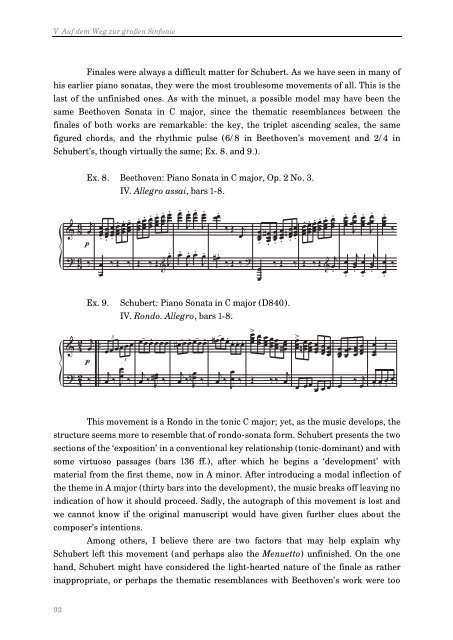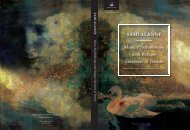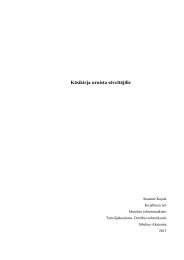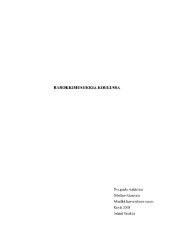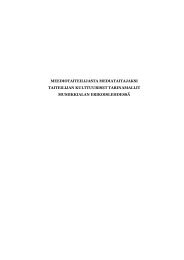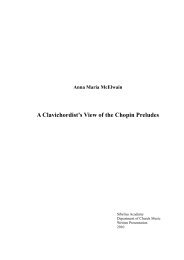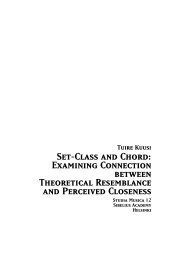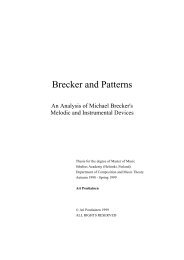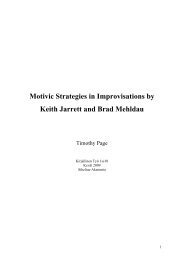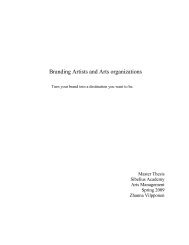The Unfinished Piano Sonatas of Franz Schubert Javier ... - Ethesis
The Unfinished Piano Sonatas of Franz Schubert Javier ... - Ethesis
The Unfinished Piano Sonatas of Franz Schubert Javier ... - Ethesis
You also want an ePaper? Increase the reach of your titles
YUMPU automatically turns print PDFs into web optimized ePapers that Google loves.
V Auf dem Weg zur großen Sinfonie<br />
Finales were always a difficult matter for <strong>Schubert</strong>. As we have seen in many <strong>of</strong><br />
his earlier piano sonatas, they were the most troublesome movements <strong>of</strong> all. This is the<br />
last <strong>of</strong> the unfinished ones. As with the minuet, a possible model may have been the<br />
same Beethoven Sonata in C major, since the thematic resemblances between the<br />
finales <strong>of</strong> both works are remarkable: the key, the triplet ascending scales, the same<br />
figured chords, and the rhythmic pulse (6/8 in Beethoven’s movement and 2/4 in<br />
<strong>Schubert</strong>’s, though virtually the same; Ex. 8. and 9.).<br />
&<br />
?<br />
6<br />
8<br />
6<br />
8<br />
Ex. 8. Beethoven: <strong>Piano</strong> Sonata in C major, Op. 2 No. 3.<br />
IV. Allegro assai, bars 1-8.<br />
j<br />
œ<br />
p<br />
œ . œ .<br />
œ .<br />
œ<br />
‰<br />
. œ . œ .<br />
œ<br />
œ<br />
‰ Œ ‰<br />
œ . œ . œ . œ . œ . œ .<br />
Œ ‰ Œ J œ.<br />
&<br />
œ .<br />
œ .<br />
œ<br />
J<br />
. œ .<br />
œ<br />
J<br />
. œ .<br />
œ<br />
J<br />
.<br />
œ<br />
J<br />
.<br />
œ œ.<br />
‰ Œ j<br />
œ<br />
# œ.<br />
‰ Œ ‰ ?<br />
œ .<br />
œ<br />
œ<br />
œ<br />
# .<br />
œ .<br />
œ n<br />
.<br />
œ.<br />
œ .<br />
‰ Œ ‰<br />
Ex. 9. <strong>Schubert</strong>: <strong>Piano</strong> Sonata in C major (D840).<br />
IV. Rondo. Allegro, bars 1-8.<br />
& 4<br />
?<br />
2<br />
4 2<br />
3<br />
j<br />
œ . œ œ œ œ œ œ œ œ œ<br />
p<br />
3<br />
j<br />
œ<br />
‰ . œ ‰ œ<br />
J ‰<br />
. œ œ œ<br />
j<br />
œ ‰ # œ<br />
J ‰<br />
# œ œ œ . œ œ œ .<br />
j<br />
œ ‰ J œ<br />
n ‰<br />
# œ œ œ .<br />
œ. œ. œ.<br />
j œ<br />
œ ‰ œ ‰<br />
J<br />
><br />
œ œ œ œ œ # œ<br />
Œ ‰ ‰<br />
j<br />
œ<br />
œ . œ . œ . œ . œ . œ .<br />
Œ ‰ Œ j<br />
& œ.<br />
><br />
œ n œ œ œ œ œ<br />
œ œ œ œ œ œ<br />
œ<br />
œ<br />
œ . œ<br />
œ œ<br />
J<br />
. œ . œ<br />
œ œ<br />
J<br />
.<br />
œ<br />
œ .<br />
j<br />
œ . œ œ.<br />
œ<br />
œ œ œ œ<br />
‰ j<br />
œ<br />
j<br />
œ .<br />
œ<br />
œ<br />
œ .<br />
œ<br />
œ .<br />
Œ<br />
‰<br />
‰<br />
œ . œ . œ . œ .<br />
This movement is a Rondo in the tonic C major; yet, as the music develops, the<br />
structure seems more to resemble that <strong>of</strong> rondo-sonata form. <strong>Schubert</strong> presents the two<br />
sections <strong>of</strong> the ‘exposition’ in a conventional key relationship (tonic-dominant) and with<br />
some virtuoso passages (bars 136 ff.), after which he begins a ‘development’ with<br />
material from the first theme, now in A minor. After introducing a modal inflection <strong>of</strong><br />
the theme in A major (thirty bars into the development), the music breaks <strong>of</strong>f leaving no<br />
indication <strong>of</strong> how it should proceed. Sadly, the autograph <strong>of</strong> this movement is lost and<br />
we cannot know if the original manuscript would have given further clues about the<br />
composer’s intentions.<br />
Among others, I believe there are two factors that may help explain why<br />
<strong>Schubert</strong> left this movement (and perhaps also the Menuetto) unfinished. On the one<br />
hand, <strong>Schubert</strong> might have considered the light-hearted nature <strong>of</strong> the finale as rather<br />
inappropriate, or perhaps the thematic resemblances with Beethoven’s work were too<br />
92


